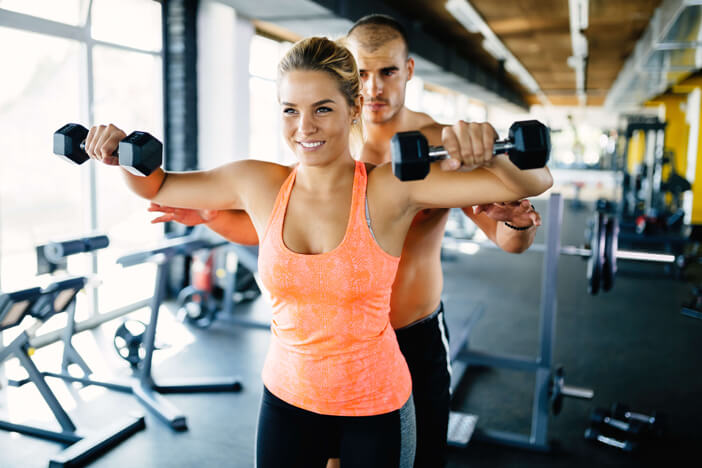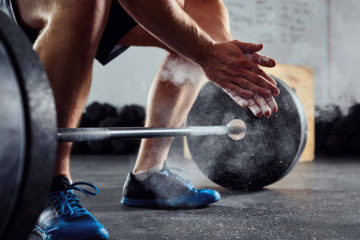Dumbbell lateral raises - a big exercise for small muscles

Lateral raises: targeted muscles
When doing lateral raises, the deltoids and supraspinatus are primarily used.
This exercise is a great addition to any upper body workout and strengthens the shoulder muscles. If you want to find out more about optimal workouts for your upper body, have a look at our pages on back training and chest exercises.
Getting the right form
Pick up both dumbbells. First stretch your arms against your body and then bend your elbows slightly. Bend your upper body slightly forward. Now raise your arms to the sides and bring them to about a 90 ° angle so that your elbows and hands are about shoulder height. Try to hold the weight for at least a second. Then slowly lower your arms back towards the starting position.
Weight recommendation for side lateral raises

As the shoulder muscles are relatively small, start with a light to medium weight.
Equipment for lateral raises
All you need is a pair of dumbbells
Lateral raises variations

Seated lateral raises
Sit down e.g. on a weight bench. Your back is straight and your thighs form a right angle with your lower legs. Now move your dumbbells sideways from your body. To do this, proceed exactly as described above. If you want to train your shoulders even more effectively, sit on a training bench so that the dumbbells touch something, e.g. the floor when you hold them down. With this method you won’t have the opportunity to gain momentum and therefore have to build up your tension with every rep from the starting position.
Bent-over lateral raises
This exercise is done while standing. Stand with feet shoulder-width apart. Pick up your dumbbells and lean your upper body slightly forward. Your back remains stable and your stomach is firm. Your chest is slightly pushed forward. Now move your dumbbells sideways from your body and lower them again. The movement should still feel like you are lifting the dumbbells, not pulling backwards like a reverse fly. If you are still unsure about the position of your upper body at an angle, lie down on an incline bench that is about 65 ° and perform the exercise as described. Your focus is now on the back of your deltoid muscle.
Cable lateral raises
Stand to the side of the cable machine. Hold the cable with the hand that is furthest away from the cable machine. Now pull the cable up until your arm is parallel to the floor. Then lower your arm again and return to the starting position. This exercise on the cable machine is particularly effective because there is a constant tension.
Typical mistakes when doing lateral raises

Side lateral raises are one of the most error-prone exercises of all. Try to avoid the following mistakes:
- Swinging: Avoid swinging your arms from your lower back. If you do this you compensate for your lack of strength with other parts of your body and neglect your shoulders. Carry out your movements in a concentrated and controlled manner. Lowering your arms, especially, should be done in a slow and controlled manner. Especially here people tend to simply let their arms drop.
- Shoulder posture: Don’t let your shoulders hang forward. This can quickly lead to a strain. So pull your shoulder blades back and squeeze them together.
- Arm posture: Avoid a 90 degree angle between the upper arm and forearm. Keep your arms almost straight, but always slightly bent. This way you achieve a large range of motion, minimize the risk of injury and prevent compensation by the trapezius.
- Exceding a 90 ° angle: Don’t go beyond the 90 ° angle. The upper trapezius (which lifts the shoulder girdle) becomes too involved which could lead to the impingement syndrome. This is a functional impairment of joint mobility.
Which workout plans contain lateral raises?
You can incorporate the lateral raises with dumbbells into your arm-shoulder workout.
Frequently asked questions
Do lateral raises 2-4 times a week with dumbbells. The increased training frequency will ultimately lead you to success.
Start with a light weight. Correct form is much more important than heavy weights. You will be able to increase your weights quickly, but always make sure that you maintain good form. If your form suffers from the increased weight, then take a step back. Always keep in mind: form over weight.
Lateral raises are one of the most error-prone exercises of all. Try to avoid the following mistakes:
- Swinging: Avoid swinging your arms from your lower back. If you do this you compensate for your lack of strength with other parts of your body and neglect your shoulders. Carry out your movements in a concentrated and controlled manner. Lowering your arms, especially, should be done in a slow and controlled manner. Especially here people tend to simply drop their arms.
- Shoulder posture: Don’t let your shoulders hang forward. This can quickly lead to a strain. Pull your shoulder blades back and squeeze them together.
- Arm posture: Avoid a 90 degree angle between the upper arm and forearm. Keep your arms almost straight, with just a slight bend. This way you achieve a large range of motion, minimize the risk of injury and prevent compensation by the trapezius.
- Exceeding a 90 ° angle: Don’t go beyond the 90 ° angle. The upper trapezius (which lifts the shoulder girdle) becomes too involved which can lead to the impingement syndrome. This is a functional impairment of joint mobility.



